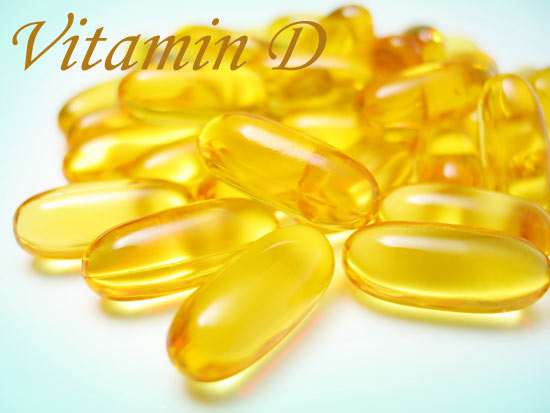
Astaxanthin : Skin Health
While aging is natural and cannot be avoided, there are factors such as solar radiation, physical and mechanical damage that accelerate the propensity of visible aging. For example, humans in general face increasing exposure to chemical pollution, ultraviolet radiation and ozone levels which damage the skin’s dermal layer causing wrinkles. These negative effects are compounded with increasingly poor diets and life-style habits which are not conducive to maintaining the skin’s natural repair process and antioxidant network. Clearly, there is an opportunity for natural ingredients to help improve long term skin health management through nutritional supplementation.
In the past, Beta-carotene (provitamin A) and Vitamin E have been extensively studied. Recent focus, however, has switched to other carotenoids such as astaxanthin, (derived from the microalgae Haematococcus pluvialis), which is shown to have potent quenching and anti-lipid-peroxidation properties; a weakness of Beta-carotene and Vitamin E (Miki, 1991).
In human trials, Astaxanthin has been shown to reduce visible signs of aging by dietary supplementation within 4 to 6 weeks of use. Research suggests potential skin benefits with the prophylactic use of astaxanthin to maintain a youthful appearance by reversing the premature signs of aging. Naturally, further investigations are necessary to elucidate the mechanism of action and replicate results using significantly larger clinical trials. To date, the astaxanthin potential is promising.
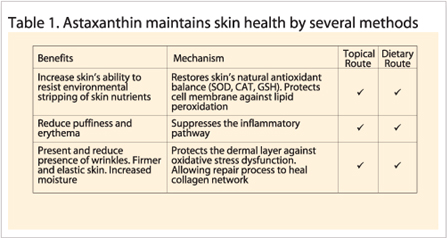
Skin Health that can be Swallowed
“Beauty from within” or improved skin condition through nutrition and supplements is a worldwide trend that is on the increase. Although the market for beauty supplements is currently worth 800 mil US Dollars, rapid growth in this segment is expected in the next 10 years.
Two human clinical trials established the use of astaxanthin to improve visible signs of premature aging and general skin health. The first double-blind placebo controlled study (Yamashita 2002), showed that astaxanthin in combination with tocotrienol (a superior form of vitamin E) improved several aspects of overall skin condition. 8 female subjects with dry skin conditions (mean age 40 years old) received a daily dose containing 2 mg astaxanthin and 40 mg natural tocotrienols. Several types of readings were collected at 2 and 4 weeks and then compared to the initial baseline readings. Measurable differences started from just 2 weeks after supplementation. By the 4th week the treated subjects with dry skin characteristics exhibited the following: increased moisture levels (P<0.05), Figure 1; consistent natural oils; reduction of fine wrinkles, Figure 2; and pimples (P<0.01).
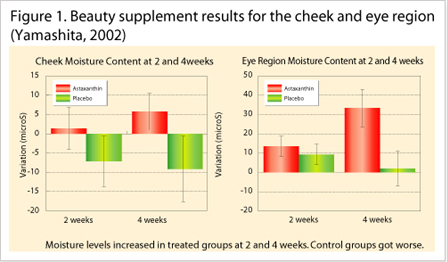
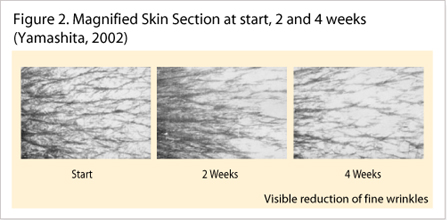
The second study by Yamashita (2006), female subjects with a variety of skin types (n=49, mean age 47) were given either 4 mg (2 x 2 mg) astaxanthin or placebo in this single-blind, randomized, controlled study. After six weeks of consuming 4mg astaxanthin per day, the results of the questionnaire showed that the treated group all felt that their skin condition had improved (Figure 3).
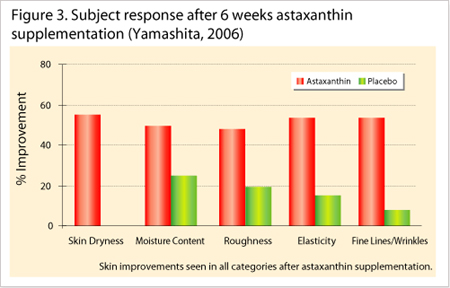
Instrument analysis showed the treated group had indeed achieved positive results in hydration (P<0.05) and elasticity (P<0.05). Furthermore, a dermatologist inspection showed wrinkle reduction (P<0.05) and improved elasticity (P<0.05) in the treated group especially between weeks 3 and 6 (Figure 4).
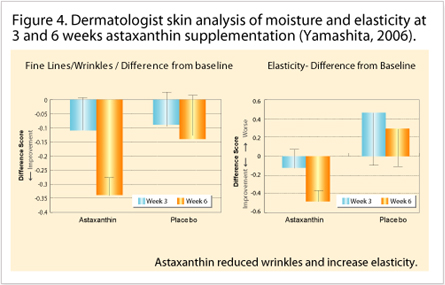
This is significant because skin regeneration usually takes between 4-5 weeks. The greatest improvement seen at week 6 supports the theory that astaxanthin protects and allows skin to regenerate.
Mechanism of Action
Skin is composed of three layers: the epidermis, the dermis, and the subcutaneous fat. The dermis contains collagen, elastin, and other fibers that support the skin's structure. It is these elements that give skin its smooth and youthful appearance – and these are the parts of the skin that are damaged by UV radiation (UVR).
The UVR that affects the skin is composed of two types of waves; UVA and UVB.UVB rays are shorter than UVA rays,and are the main cause behind wrinkle formation and melanin production. However, it is the UVA rays,with their longer wavelength , that are responsible for much of the damage associated with photoaging. UVA rays penetrate deep into the dermis, where they damage collagen fibers, leading to wrinkle formation (Figure 5)
.(Figure 5). .
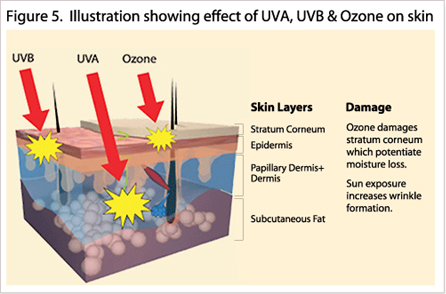
UV rays induce the production of in situ radical oxygen species (ROS) and matrix metalloproteinases (MMP). These factors are the root of wrinkle formation because they destroy the collagen matrix in the dermis. Fortunately, the skin’s repair mechanism will rebuild the damage collagen. However, the hindrance of skin renewal by repeated exposure to uncontrolled levels of ROS and MMP leads to the formation of wrinkles. The presence of astaxanthin attenuates the effects of reactive oxygen and MMP and therefore, it allows the skin to regenerate properly (Figure 6).
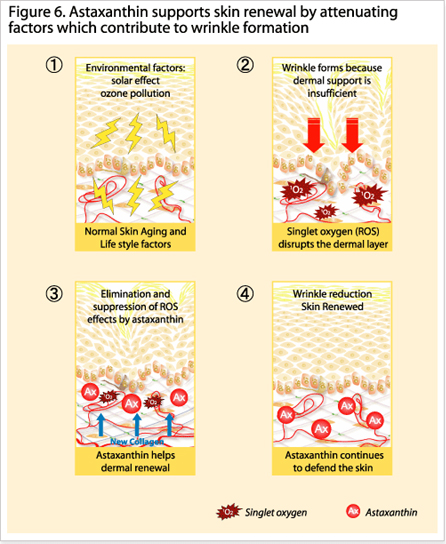
Astaxanthin defends against Reactive Oxygen Species(ROS)
Oxygen present in our cells can from harmful radicals know as ROS or active oxygen when sufficient energy from UV rays is applied. ROS include singlet oxygen, superoxides and hydroxyl radicals (leading to peroxyl radicals) and they attempt to steal electrons from neighboring molecules such as DNA, phospholipids, enzymes and protein in order to stabilize. Fortunately, astaxanthin is able to quench singlet oxygen reactions and suppress lipid peroxidation much more effectively than other well know antioxidants and thus control the presence of ROS.
Anti-inflammatory Action
Inflammation that normally follows sun exposure can be modulated by a powerful antioxidant. Yamashita(1995) shows in healthy male subjects (n=7), that topical natural astaxanthin significantly reduces burn level (erythema)by 60% at 98 hours after UVB exposure. We now know that astaxanthin works by suppressing the proinflammatory mediators and cytokines via the IkB kinase dependant NF-kB activation pathway (Lee et al.,2003)
Safety for Topical & Nutritional Use
Astaxanthin is determined safe for topic use. A total of forty-five subjects(males and females) were exposed to the Standard Japan Patch test and results were reported 24 and 48 hours after application. Dermatitis was only induced by the adhesive plaster and not astaxanthin itself (Seki et al.2002.) Furthermore ,Koura (2005) reports no adverse topical reactions in animal sensitization models. Astaxanthin is listed in the JP Cosmetic and INCI name as Haematococcus pluvialis extract.
Outlook
Naturally, the best method to stop photo-aging is through removal of the harsh environmental effects on skin with sunscreen to areas vulnerable to photo-aging. Furthermore, the environment tends to strip away the nutrients essential to maintain the skin’s hydrolipidic barrier. However, recent surveys reveal that people in general are not doing enough to protect their skin. Restoration of the skin’s natural antioxidant balance is one alternative and convenient method to maintain healthy skin. Therefore, the use of powerful carotenoids like astaxanthin in nutritional dietary supplements can help deliver the benefits against photo-aging of the skin.
References
1. Yamashita, E., (2006), The Effects of a Dietary Supplement Containing Astaxanthin on Skin Condition. Carotenoid Science, 10:91-95.
2. Yamashita, E., (2002), Cosmetic benefit of the supplement health food combined astaxanthin and tocotrienol on human skin. Food Style 21 6(6):112-117.
3. Miki, W., (1991), Biological functions and activities of animal carotenoids. Pure & Appl. Chem., 63(1):141-146.
4. Lee, S.J.et al., (2003), Astaxanthin Inhibits Nitric Oxide Production and Inflammatory Gene Expression by Suppressing IkB Kinase –dependent NF-kB Action.Molecules and Cells, Vol.16,No.1,pp.97-105
5. Seki ,T.,et al.,(2001) , Effects of astaxanthin from haematococcus pluvialis on human skin.France Journal 12:98-103.



